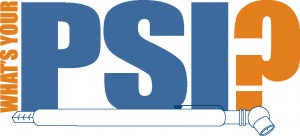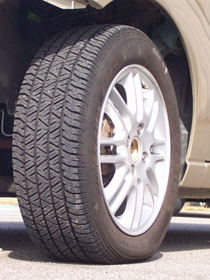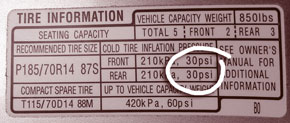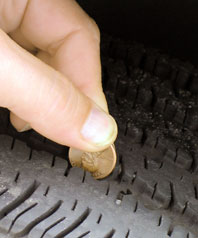Do you know the correct PSI for your vehicle’s tires?
 The “What’s Your PSI?” campaign is designed to challenge consumers to learn the correct tire pressure (pounds per square inch or PSI) for their vehicle’s tires, help them to maintain proper pressure — and ultimately help everyone avoid tire failure and crashes.
The “What’s Your PSI?” campaign is designed to challenge consumers to learn the correct tire pressure (pounds per square inch or PSI) for their vehicle’s tires, help them to maintain proper pressure — and ultimately help everyone avoid tire failure and crashes.
In addition to making road travel safer, inflating tires to the correct PSI has other benefits as well. Motorists who “know their PSI” and maintain it can help to optimize fuel economy and tire life, saving dollars and protecting our environment in the process.
National Tire Safety Week
Look for NHTSA’s “What’s Your PSI?” and the Rubber Manufacturers Association’s (RMA) “Be Tire Smart, Play Your PART” campaign materials at tire safety partner locations throughout the country.
Key Tire Care Messages
All motorists need to check their tire pressure at least once per month.
You can’t tell correct tire pressure just by looking. Use an accurate tire pressure gauge to measure pressure when tires are “cold” — meaning they haven’t been driven on for at least three hours.

(50% recommended pressure)

(100% recommended pressure)
The correct PSI or pressure for your tires is listed on your vehicle’s tire information label or in your owner’s manual, not what’s on the side of the tire.

Check the overall condition of your tires, particularly the tread and sidewalls, at least once a month.
Use the Lincoln’s head penny test, or look for the built-in wear bar indicators to determine when it’s time to replace your tires. Place a penny in the tread with Lincoln’s head upside down and facing you. If you can see the top of Lincoln’s head, you are ready for new tires.
The tread on this tire covers the top of Lincoln’s head, so it’s not yet ready for replacement

Make note of any irregular tread wear. This could be an indication of a wheel misalignment, the need for a tire rotation, or both. Uneven tread wear is a sign that you need to take your car in for servicing.
downloads and links
- Download the PDF version of the “What’s Your PSI?” brochure
- General Information FAQ
- Tire Aging
- Tire Defects
